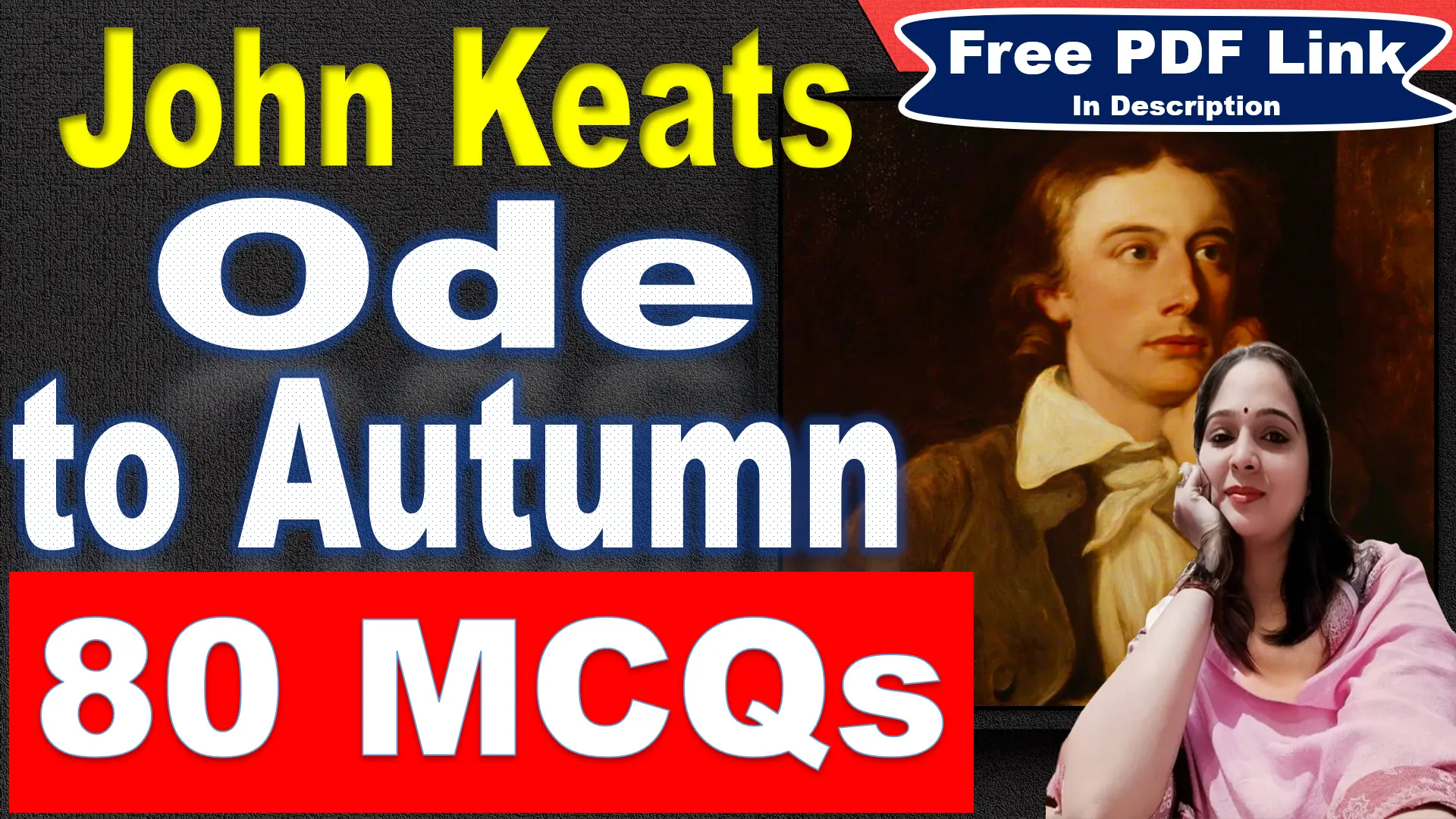
The Last Ride Together Questions and Answers
Very Short Answer Questions
Who wrote The Last Ride Together?
Robert Browning.
What form is The Last Ride Together written in?
It is a dramatic monologue.
How does the speaker react to his beloved’s rejection?
He gracefully accepts it and requests a final ride together.
What is the main theme of the poem?
The theme is unrequited love and finding fulfillment in the present moment.
What does the ride symbolize for the speaker?
It symbolizes a final moment of connection and acceptance.
What rhyme scheme does the poem follow?
AABBCDDEEEC.
How does the speaker feel during the ride with his beloved?
He feels a mix of joy, fulfillment, and philosophical reflection.
Why does the speaker compare himself to a soldier and a statesman?
To show that his simple happiness is more meaningful than grand ambitions.
What is the significance of the phrase “life for ever old yet new”?
It represents the speaker’s vision of a timeless, eternal experience with his beloved.
How does the speaker view poets and artists in the poem?
He respects their dedication but questions if they find true fulfillment.
What does the speaker envision as heaven?
An eternal ride with his beloved.
What type of love is depicted in the poem?
Unrequited and idealized love.
What is the tone of the poem?
Reflective and contemplative.
What does “life’s flower” symbolize in the poem?
It symbolizes the peak or essence of life’s beauty.
What does the speaker ultimately find satisfaction in?
In the fleeting moment of riding with his beloved.
How does Browning explore human aspiration in the poem?
By comparing the speaker’s contentment with the incomplete ambitions of others.
How does the speaker feel about missed opportunities?
He accepts them and chooses to focus on the present.
What does “the instant made eternity” mean in the poem?
It means that a perfect moment can feel timeless.
Why does the speaker feel “deified” during the ride?
Because he feels a sense of divine joy and fulfillment.
How does the speaker describe the beloved’s silence?
As a profound and meaningful part of their experience.
What is the “glory-garland” a metaphor for?
It represents the idealized, ultimate happiness the speaker envisions.
What kind of literary devices does Browning use heavily in the poem?
He uses imagery, metaphor, and rhetorical questions.
How does the speaker contrast earthly life and heaven?
He wonders if heaven would truly be better than the fleeting joys on earth.
What kind of moment does the speaker cherish with his beloved?
A simple, intimate, and perfect moment.
What is the significance of “fix’d so, ever should so abide”?
It suggests a desire for the moment to last forever, as if frozen in time.
Why does the speaker feel at peace at the end of the poem?
He accepts the beauty of the present and his unfulfilled love.
What is the tone of the poem’s final line?
Hopeful and idealistic.
How does the poem reflect Browning’s view on life’s limitations?
It suggests that acceptance of life’s imperfections can lead to contentment.
What is the purpose of the rhetorical questions in the poem?
To explore the speaker’s inner doubts and philosophical reflections.
What does the speaker ultimately find more valuable than ambition or fame?
The immediate, shared experience of the ride with his beloved.
Short Answer Questions
How does the speaker react to his rejection by the beloved, and what does this reveal about his character?
The speaker responds to his rejection with calm acceptance and grace, choosing to cherish a final shared moment rather than dwelling on resentment. His request for “one more last ride” shows a reflective and mature attitude, as he seeks closure through connection. This reaction reveals his ability to find beauty in loss and suggests a deep appreciation for fleeting experiences.
How does Browning use the idea of a “ride” as a metaphor in the poem?
The “ride” serves as a metaphor for life’s journey, especially the speaker’s journey through love, acceptance, and self-reflection. It represents his last connection with his beloved, where he accepts the impermanence of love and finds fulfillment in a shared moment. The ride also symbolizes his philosophical journey, moving from regret to a sense of peace and appreciation for the present.
What is the significance of comparing the speaker’s experience to the achievements of soldiers, statesmen, and poets?
The comparisons highlight the speaker’s belief that simple, personal moments can be more fulfilling than grand achievements. While soldiers and statesmen often pursue recognition and fame, the speaker finds that these ambitions rarely lead to complete satisfaction. In contrast, his quiet, intimate moment with his beloved feels more genuine and satisfying, suggesting that ordinary joys may surpass lofty aspirations.
How does Browning explore the theme of unfulfilled desire in the poem?
Browning examines unfulfilled desire through the speaker’s reflection on missed opportunities and the gap between aspiration and reality. The speaker accepts that his love will remain unreturned and that human ambitions often go unrewarded. This theme is underscored by his philosophical acceptance of life’s limitations, suggesting that fulfillment may come not from achieving desires but from appreciating the beauty of impermanent experiences.
Describe the tone of the poem and how it shifts throughout the speaker’s reflections.
The poem’s tone is contemplative and bittersweet, blending acceptance with philosophical musings on love and life. Initially, the speaker expresses calm resignation, then moves through self-reflection, regret, and eventual appreciation for the present. By the end, the tone shifts to one of hopeful contentment, as he envisions an eternal ride, turning his sense of loss into something idealized and beautiful.
How does the speaker view heaven, and what does this reveal about his outlook on life?
The speaker envisions heaven not as a distant, abstract paradise but as a continuation of the present moment—a perfect, timeless ride with his beloved. This vision reveals his preference for finding meaning and happiness in earthly experiences rather than idealized expectations. It suggests a belief that fulfillment is achievable in simple, present moments, rather than in unattainable ideals.
Why does the speaker use rhetorical questions throughout the poem, and what effect do they have?
The speaker’s rhetorical questions reflect his inner doubts and philosophical musings, inviting readers to ponder life’s complexities with him. These questions emphasize his uncertainty and curiosity about love, success, and human aspirations, making his reflections more personal and engaging. They create a contemplative tone, allowing readers to explore the themes alongside the speaker.
What role does imagery play in the poem, particularly in describing the beloved and the ride?
Imagery in the poem vividly captures the beauty and depth of the speaker’s emotions, particularly in descriptions of his beloved as a radiant, divine figure. The imagery of “life’s flower” and “glory-garland” conveys his idealization of the ride and the moment. Through rich, evocative imagery, Browning brings the reader into the speaker’s experience, making the ride feel timeless and almost heavenly.
How does the speaker’s view on art and ambition relate to his own experience of love?
The speaker suggests that artists and ambitious figures often fall short of achieving true fulfillment, despite dedicating their lives to lofty goals. By contrasting his simple joy with their incomplete achievements, he implies that personal experiences and connections, like his ride with his beloved, may be more valuable. This view reinforces his belief that love, even if unfulfilled, holds profound meaning in life.
How does Browning address the theme of time in The Last Ride Together?
Time is portrayed as both fleeting and eternal in the poem. The speaker cherishes the brief, final ride, acknowledging its impermanence while imagining it as an idealized, timeless experience. Through the line “The instant made eternity,” Browning suggests that moments of beauty and connection can feel eternal, making time less of a constraint and more a state of mind in the search for fulfillment.





